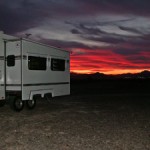 Replacing a standard ceiling vent with a fan-powered vent gives you more ways to keep your RV interior comfortable in any weather. Here’s how you can do it yourself and save:
Replacing a standard ceiling vent with a fan-powered vent gives you more ways to keep your RV interior comfortable in any weather. Here’s how you can do it yourself and save:
How To Do It
1. Make sure the vent location is at least 3 feet away from any sewer system roof vent, if the new vent and fan will have air intake capability, to conform with national safety codes for RVs.
2. Turn off all 12-volt power to the existing vent.
3. Remove the old assembly inside and out, carefully removing all old roof sealant. Surfaces inside and out must be clean and dry.
4. Check the fit of the new vent fan. The hinge must face toward the front of the RV. Verify correct wiring size and length to hook up the new assembly. Make sure that a properly sized fuse is in the circuit providing power to the vent and fan. Check inside ceiling flange clearance. Fill any extra holes in roof exterior with wood putty or sealant to ensure a better seal later.
4. Apply 1″ butyl putty tape around the mounting hole pattern on roof side of fan chassis. Center tape over mounting holes.
5. Place new vent fan assembly on roof and check alignment inside and out.
6. Screw assembly to roof. The screws from the old assembly can be used if not rusted or damaged.
7. Seal all edges and screws with silicone sealant or EPDM rubber roof sealant on rubber roofs. Do not allow sealant to contact the dome hinge or rain sensor.
8. Check wire polarity and connect wires inside of coach. Coach wires are either black (-) and red (+) or white (-) and black (+).
9. Test the hand crank by turning clockwise to open dome. If vent fan has a power dome, turn on power to assembly and test switch for proper operation.
10. Place lower trim flange in place and secure with screws provided.
Cool, Fresh Air
You are now ready to use your fan powered vent to draw cool, fresh air into your RV or to eject stale air and odors, if your new vent fan is reversible. Models such as the ComfortAir™ line of vents also allow closed-dome operation to work with your air conditioning and heating systems to maintain comfortable temperatures throughout your RV living area.
